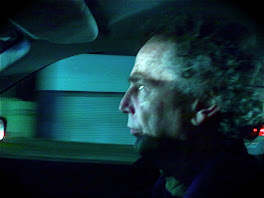Sunday, October 09, 2005
there is joy in being where the angels are
Just took a drive out to Rookwood, the cemetery a few suburbs west of here. It goes Ashfield, Croydon, Burwood, Strathfield, Lidcombe. Running more or less along the southern side of the Western line the whole way until you hit Centenary Drive, a major north-south artery and go left and then right. Through a works depot, past the Lidcombe mail exchange—I nearly got assigned there once years ago when I worked as a postal officer—and in the ornate sandstone and iron lace gates on to fetchingly named Necropolis Drive. Rockwood Necropolis is the largest cemetery in the Southern Hemisphere, my Sydway says. It is the final resting place of nearly one million people. That's a lot of bones I think as I drive slowly through open grassy fields where tombstones stand, lean, or topple in all directions. It looks like some crazy chessboard, endless, as if a forgetful god were playing an infinitely complex game with himself before losing interest and going off elsewhere. The day is warm, blue, blustery, a buffetting wind blows from the south west, strong enough to rip small branches off the eucalypts and strew leaves along the paths. I'm not here for any special reason, it's just a recce, I'll probably come back with actual questions to ask some other time; today I just want to get a feel for the place. I go right to the end of Necropolis Drive until it turns into Necropolis Circuit, with the Martyrs Memorial in the middle of it. Round the circuit and there, on the left, I see the old section I've sometimes looked at from Railway Street at night when I've been out in the cab. Down here the tarmac is pot-holed, the seal is disintegrated, it's like being on some country road in the backblocks. I park the car under a tree, get out and start walking amongst the graves. They're mostly from the 1880s, English names ... later I find out it's the Anglican sector, maybe even Old Anglican, because Rookwood is demarcated along religious lines. There seem to be a lot of people native of Manchester. Even the impressive and intact white marble column of the paterfamilias of a Greek family, native of Athens, turns out to have had a Mancunian materfamilias. One of their daughters was Aphrodite, she died young. There are odd names: Glasscock strikes me strangely, as does one Tan Dann, whose monument is so faded I can't make out anything else about him ... or her. As I walk the landscape becomes wilder, the trees bigger, the gravestones more tumbled or, in many cases, missing altogether. I come to a place where a swarm of honey bees has made a hive in a crack in the bole of an old blackbutt tree. Bees start flying into the back of my head as I stand there looking at it. Not far away is a set of commercial hives, about a dozen of them, which seems curious: who harvests honey from the fields of the dead? There is a metallic smell, clean, antiseptic, emenating from these hives, I don't know why. Here's a pond with the headless statue of a young woman in the centre; the water is cloudy with yellow weed and there is a new, newly abandoned brickwork canal leading to and from the pool, which is old. I wonder if this is the bed of a natural stream? Past the pool it's starting to look like real Australian bush and I recall that, when the local authority announced they wanted to clear the bones from some sections so that they could be re-used, conservationists answered that there are unique relict stands of the original flora of the Cumberland Basin in Rookwood, plant communities that no longer exist anywhere else. I turn and go back a different way, walking through fields of knee-high brown grass and wild flowering ixia and spraxia, thinking about snakes. A hare breaks from under a tree and goes drumming away down the hill. I see it sitting at the bottom of the hollow, its long ears raised up. I come to a grave that has been paved with very beautiful old ceramic tiles, some of which have broken or come loose. I pick up a couple of fragments, then very carefully replace them where they were, remembering the last line of Shakespeare's epitaph: Cursed be he who moves my bones even though these are not bones, just tile fragments. Near an enclosure fenced with heavy iron chains, anchors as posts, where sailors are buried, I find the daisies I've been looking for and pick half a dozen. Stark white with purple centres that crimson as they age. I take them back to the car and drive away, randomly. Near the Chapel for the Independents, someone has been practising topiary on the shubbery, cutting the bushes to look like tombstones; they are truly bizarre. Then I'm in the Catholic section, which is shiny and bright and busy, like an open air mall. Later I pass by the crematorium and with a pang recall that I have been here once before, Maundy Thursday, 2003, when Paul's body was burned.
